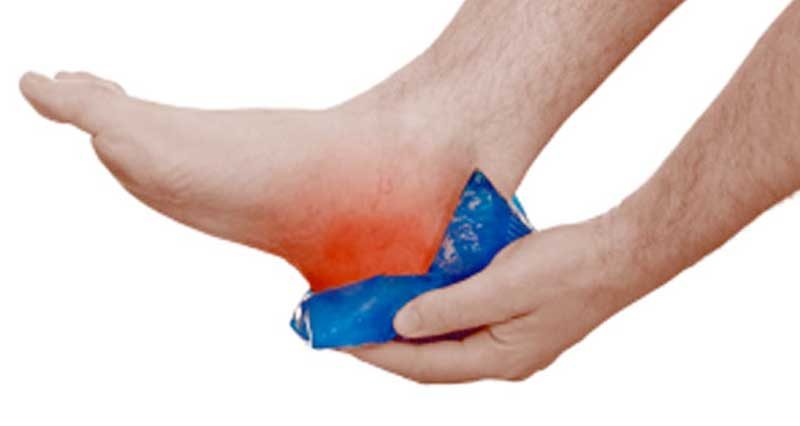There are numerous methods which can be used to apply different forms of cold therapy. Which one to use will depend on the body part to be cooled and the type of injury present.
Ice packs
An ice pack is any type of container which holds crushed or chipped ice. It can be a plastic bag, towel or specially designed ice bag.
These tend to cool the underlying tissues more efficiently than commercial chemical or frozen gel packs and remain cold for a longer period. They can be held in place if required by an elastic bandage or specialist wrap.
Ice baths
An ice bath can easily be made by half-filling a large container/tub with cold water and ice. The size of the container and the depth of the water required depends on the body part to be treated. This is the best method of cooling awkward, bony areas, such as the foot, ankle, hand, and elbow.
Immediately following injury, submerging the injured body part may not be as beneficial as using a cold pack and compression wrap, as there is no compression (RICE principle). Wrapping the ankle prior to submersion will also prevent maximal cooling by insulating the body part.
Ice massage
Ice can be used to massage the affected area. Usually, cubes are frozen with some form of a handle (a simple lollypop stick will suffice) in order to protect the hands of the masseur. This method is most suitable for injured muscles and larger areas. The ice should be stroked up and down the injured muscle.
The disadvantage of this type of massage is that the application is phasic, that the ice is in contact with each area only briefly. Following this, it is exposed to air temperature which reduces the efficacy of tissue cooling. However, numbing the area is quite efficient due to the movement of the ice-stimulating mechanoreceptors in the muscles.
Gel packs
These commercially available packs contain a gelatinous substance which is kept frozen in a freezer until required. Better examples contain some form of anti-freeze which prevents the gel from freezing into a rigid position, allowing the pack to be moulded to the shape of the body part.
These are good for use in a clinic setting as they are reusable and not as messy as ice packs. However, when taken out of the freezer they immediately begin to thaw and so are not suitable for use on the field of play. They must also be applied to the skin through a towel or cloth to prevent frostbite.
Instant ice packs (chemical)
These are one-use cold packs where compressing and rupturing a central pouch, contained within the pack, releases a second chemical which causes a reaction which lowers the temperature of the pack.
These packs do not lower in temperature enough to significantly reduce tissue temperature. They are however convenient for emergency use. Any leak from the pack would cause a chemical burn.
Vapocoolant sprays
These sprays evaporate quickly when they come into contact with the skin. This removes heat from the skin at the same time. They result in only a very superficial cooling effect and therefore are limited in their efficiency.
Cryocuff
The Cryocuff is a machine which consists of a gallon tank of ice water and a nylon sleeve, into which you place the injured part. The ice water flows through the cuff to cool the body part. The tank must be raised to allow more water to flow into the cuff and increase the pressure. In this way, compression is also applied to the injury.
To cool the water sitting in the cuff, the tank is lowered to allow it to flow back into the tank where it mixes again with the ice water. The tank can then be raised again to fill the cuff. The Cryocuff allows a good degree of cooling and compression and is relatively portable and reusable. Different shapes and sizes of the cuff can also be purchased to allow use for all body parts.
Medicated ice for abrasions
When a skin injury occurs, the RICE procedure should be followed. In order to also prevent infection, the ice you apply can be combined with an antiseptic. In a plastic cup, mix together distilled or boiled water with 10% povidone-iodine and 2% lidocaine.
Secure a lollypop stick or similar in the centre with tape and freeze. When required, roll the ice back and forwards over the skin for about 10 minutes. and then treat it as normal.
Cooling during exercise in a hot environment
There are a number of suitable methods available to reduce body heat when playing sports in a very hot environment. Wearing a cold pack around the neck and or forehead during breaks in play is a simple method as is draping a towel soaked in hot water over the head.
More specialist kit includes a vest such as the Dura-Kold vest which is designed to be worn during breaks and reduces body temperature quickly. Having a fan on the sidelines and getting athletes to stand in front of it during breaks in play can also help.
Minimising cold sores and blisters
If caught early, applying ice can reduce the development of both cold sores and blisters. As soon as you feel either forming, wrap 2/3rds of an ice cube in a cloth or plastic bag and apply the exposed edge directly to the skin.
Hold in place for up to 2 hours! Alternatively, a bucket of ice water can be used for blisters on the feet, hands or elbows (submerge for 10 minutes).
